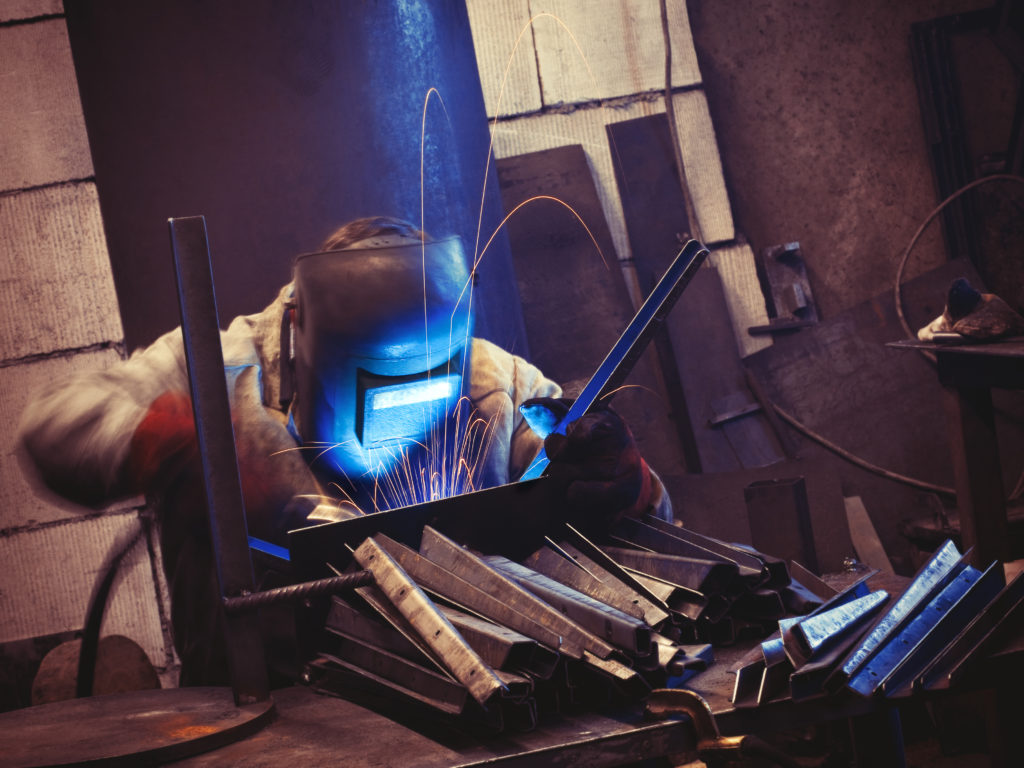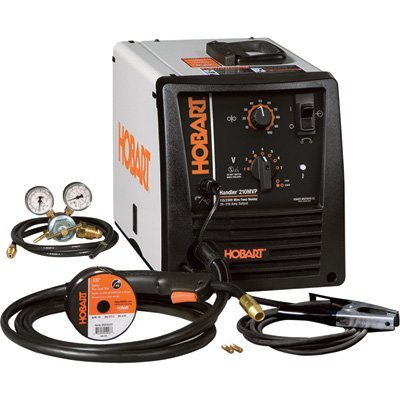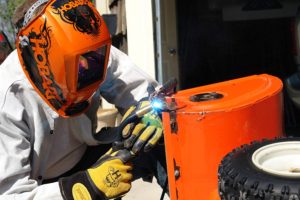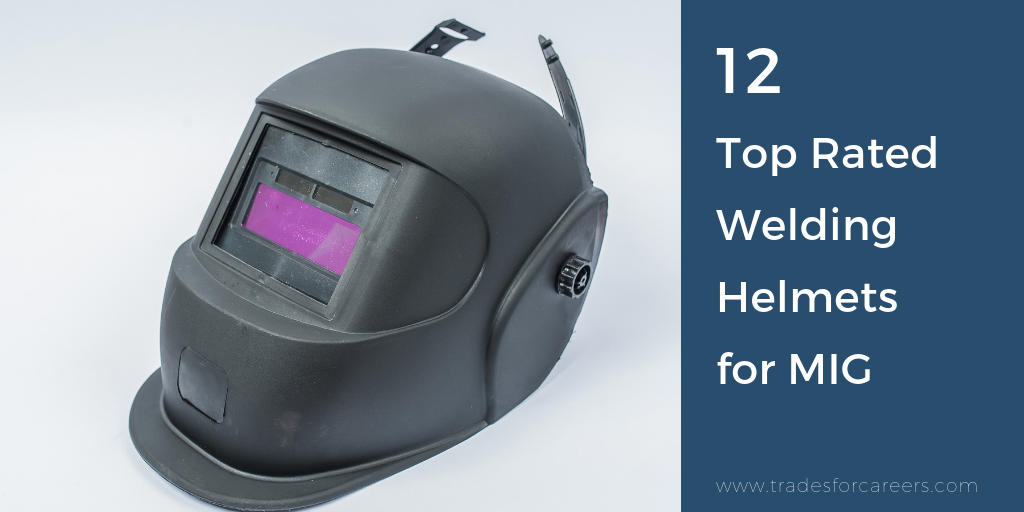In this complete guide to MIG welding for beginners, you’ll find that this is one of the easiest types of welding processes. In the following post, you’ll find charts, supplies tips, video guides, and everything that falls under the “Mig Welding Basics” umbrella.

Mig Welding for Beginners: Table of Contents
- MIG Welding Definition
- Advantages & Disadvantages of MIG Welding
- MIG Welding Tips for Beginners
- Top Rated MIG Welding Charts
- The Best MIG Welding Supplies Online
- Stick Welding vs MIG vs Flux Core Welding vs TIG
- How do I choose MIG wire welding types?
- What gas does a MIG welder use?
- Can I do MIG welding without gas?
MIG Welding Definition: What does MIG stand for in Welding?
MIG welding stands for Gas Metal Arc Welding (GMAW) or Metal Inert Gas Welding (MIG). Sometimes, the term is used interchangeably with aluminum welding.
However, TIG welding is another popular method for welding thicker aluminum.
Basically, MIG welding is the method for joining aluminum and other non-ferrous metals, like steel. It requires steady electricity for heat production, an electrode for joint filling and shielding gas to protect your weld from air.
The Pros and Cons of Mig Welding for Beginners
There are both advantages and disadvantages to MIG Welding. Below, you’ll find key points to find if this is the right type for you.
Advantages of MIG Welding
By and large, MIG welding has a lot of advantages:
- First, it’s the easiest welding process to learn.
- It also makes welding thinner metals easier and provides more control. That’s why it’s great for aluminum welding! Mig welding stainless steel is also a common practice.
- Another benefit is that you can weld quickly.
- Also, the MIG method reduces spatter and scrap.
- Finally, investing in a MIG welder is a good idea. This is because most mig welding machines are compatible with other welding processes
Disadvantages of MIG Welding
Like everything in life, there are a few drawbacks to MIG welding:
- Unfortunately, it lacks the kind of penetration needed for welding thicker metals
- Additionally, this process doesn’t work well outdoors. This is because of its sensitivity to wind, which can easily interfere with the MIG welding gas flow rate and mix.
- Unfortunately, it lacks the kind of penetration needed for welding thicker metals
- Finally, due to the fluid welding puddle, it doesn’t work in vertical or overhead welding positions
Safety First: MIG Welding Tips for Beginners
Even though this is the easiest welding method, here are some tips to make it even easier on yourself:
- First and foremost, make sure you’re wearing the proper protective gear, such as an auto darkening welding helmet or steel toed work boots.
- Second, maintain control by always making sure the wire is pointed at the weld pool’s edge.
- Another important MIG welding tip is to do your research. Read online reviews carefully, make sure you have an up-to-date MIG welding chart, and study your welding machine’s owner manual.
- It’s also essential to make sure you’re using the correct type of MIG wire and gas.
- Before any project, make sure everything’s connected properly on your machine.
- Last of all, maintain a clean environment at all times. Most importantly, watch out for excess paint and rust.
Video: How to MIG Weld for Beginners
Mig Welding Chart
As discussed in the “Mig Welding Tips for Beginners” section, it’s important to have a good Mig welding chart. Whether it came along with your new MIG welding machine or your get a cheap one from Amazon, follow it closely.
Important Mig Welding Supplies
In order to use the gas metal arc method, you’ll need the right MIG welding supplies. For example, you’ll need things like:
- MIG welding gun parts
- MIG welding torch
- Correct Mig welding wire types
Additionally, you’ll need proper Mig welding gloves, an auto darkening welding helmet, and a whole slew of personal protection equipment.
For reviews of all the essentials, see Reviews of the Best Welding Supplies Online: Buyer’s Guide 2018.
Featured: Best Mig Welder for Beginner & Home Use
Hobart Handler 210 MVP Review
Many novices ask what type of welder do I need? And it’s no wonder! With all of the great MIG welding machines for sale, it can be hard to figure out which is the best kind for you. (Not to mention your budget!)

Although there are plenty of high quality welders on the market, we’ve chosen to feature the Hobart 210 Mig Welder. It’s a great choice if you plan on Mig welding aluminum with spool gun.
Highlights of the Hobart Handler 210:
- Compatible with both 120v and 220v outlets
- Functions well with multiple types of gauges and wires
- 3 simple, easy-to-use controls
- Comes with a Mig Welding Chart included
- Hobart offers the SpoolRunner 100, a Mig welding gun that makes aluminum welding easier than ever.
- Because it’s nearly splatter-free and easy-to-use, this is our Editor’s Choice for both the best MIG welder for home use and the best MIG welding machine for beginners!
- Finally, it’s one of the best MIG welders under 1000 dollars!
For an in-depth review, see Hobart Handler 210 MVP Review: To Buy or Not to Buy?
Featured: Best MIG Welding Helmet for Sale
Hobart 770754 Impact Variable Auto Darkening Welding Hood
Over the years, Hobart has earned a reputation for making the best welding supplies. And their 770754 best MIG welding helmet is no exception! This is for a lot of things, such as its long warranty, generous shade range, and 2 year warranty.

Highlights of the Hobart 770754 Impact Variable Mig Welding Helmet:
- First, innovative LCD lens technology, auto darkening lenses, and an automatic on/off switch, this machine
- Since it’s crafted from polymide, this welding hood is both lightweight and durable. In other words, it’s strong enough to shield you from heat and flames, but it’s light enough that you can work for hours without feeling fatigued from wearing it.
- Finally, this MIG welding helmet is versatile, and it works for other kinds of welding processes.
- As if those aren’t factors enough, this auto darkening welding helmet is great for TIG welding and grind mode.
- All in all, this one of the best auto darkening welding hoods for sale today.
-
For reviews of 11 more great MIG welding hoods, see The 12 Best Rated Welding Helmets for Mig.
Comparison of Arc vs MIG vs Flux Core Stick Welding Types
Even when you understand MIG welding basics, it can be tricky to tell apart the different welding methods. This is because they have a lot of overlap and sound the same to the uneducated mind. (MIG welding tip #1: Get your welding certification from a top welding school near you. This way, you can explore more different kinds of welding in a safe environment.)
Arc vs MIG Welding Methods
In general, the Arc vs MIG welding method comparison shows quite a lot of similarities:
- Both methods safety precautions and gadgets to protect yourself from injury.
- Also, they both require that you prepare a clean joint that has no rust, paint or water.
- For both methods, you need to ensure extremely accurate amperage and polarity set-up.
- Best of all, both Arc and MIG welding methods are relatively easy for beginners to get the hang of.
Video: Mig vs Arc Welding – Which Welder Then?
Flux Core Welding vs MIG (MIG Welding Without Gas)
First, let’s establish a brief definition of Flux Core Welding. In short, it’s very similar to MIG welding. In fact, you could say it’s the same as MIG welding but without gas. Instead of gas, the machine uses direct current (dc) power.
Usually, Flux Cored Welding is automatically fed by a spool gun. This wire contains consistent voltage and a flux material.
Most notably, there are two main technical differences in Flux Core Welding vs MIG
- First, ongoing voltage from dc power is necessary for the Flux Cored welding method.
- Second, this process requires a different type of wire. Instead of the solid wire for MIG, Flux Cored welding wire is coated in metal and “stuffed” with a flux material.
Fortunately, almost all MIG welding machines also have Flux Cored welding capabilities.
More Differences between Flux Cored Welding and MIG
- Unfortunately, flux core welding produces more spatter than Mig welding.
- However, flux core welding can penetrate thicker metal, while Mig welding only penetrates thin steel. This makes flux cored welding best for industrial purposes like building bridges and performing heavy duty repairs.
- Especially for beginners, Flux Cored welding doesn’t facilitate as smooth of a finished weld.
- Another difference is that Flux Core welding doesn’t require as much constant clean up.
- Unlike MIG welding, the Flux Core method is possible in verticle and overhead positions. When combined, however, your metal becomes more solidified and easier to welding in several positions.
- Because of Mig welding’s sensitivity to wind, it is usually done indoors. Flux core, however, can be done outdoors. Yet another reason it’s a good welding method for professionals!
Stick Welding vs MIG Welding Process
Comparatively, Mig Welding vs Stick Welding are different from each other in important ways.
- First of all, MIG is the easiest method to learn. For this reason, we recommend that welding students first master MIG welding basics. After that, it’s time to look at the Stick method.
- Another difference is that MIG welding is a faster process. As a result, longer welding projects are more feasible.
- Perhaps the most convincing reason that MIG is the best method for beginners is that it makes it easier to perform smooth, clean welds.
- Despite MIG’s benefits, it’s difficult to perform welding job outdoors. (Due to its use of gas.) Comparatively, the Stick welding method is best for outdoor projects.
TIG vs MIG Welding
Simply put, TIG (Tungsten Inert Gas) welding is different because it uses tungsten electrodes that are non-consumable.
In comparison to the different types of welding methods above, TIG welding provides higher quality welds. But at what cost? Consult the list below to decide which type is best for your uses.
Differences Between TIG & MIG
- Due to the non-consumable tungsten electrodes, the material won’t melt until temperatures are far higher than they need to be for MIG.
- Since it involves a lot of coordination (with a foot pedal and TIG torch), this is much more advanced and difficult to learn.
- In comparison to MIG, it takes a lot more time to complete TIG welding tasks.
- Overall, TIG provides the most professional welds of all. It’s just a method that takes a lot longer than MIG. Therefore, we suggest Stick or MIG if you want something fast and relatively simple.
How do I choose MIG Welding Wire Types?
Notably, the type of welding wire you choose can make or break your project. To get the best results, you should consult a MIG welding chart., and your welding machine’s handbook.
Better yet, consult a professional MIG Welding Guidebook.
Types of Welding Gases: What gas does a MIG welder use?
Simply put, helium and argon gases work well for metals that don’t contain iron. So for aluminum welding, you’ll probably want to use argon gas. However, that wouldn’t work well for steel. Sometimes people use carbon dioxide, but this can be messy. Also, it doesn’t have a reputation for producing strong welds.
Therefore, it all depends on your specific project. In the video below, you’ll learn what gas is used for MIG welding.
Can I do MIG welding without gas?
Technically, no. MIG welding without gas is Flux Cored welding, which we’ll get to in the welding method comparison section. However, it is true that you can use a MIG welding rig to do Flux Cored welding. Just make sure to use a flux core wire.
Video: Best Gas for MIG Welding
Here’s a handy video from Lincoln Electric that explains how to choose the best gas:
MIG Welding For Beginners: Final Thoughts
After looking at this overview of Gas Metal Arc Welding basics, we hope you found the answers you were looking for. If you plan to MIG weld in the future, we invite you to bookmark this page and reference it as needed.
Most importantly, be safe and have fun on your new welding endeavors!
Readers who liked “The Ultimate Guide to Mig Welding for Beginners” also read:
Badass Welding Hoods: 8 Awesome Welding Helmet Designs
Finding the Best Multi Process Welder: All in One Welder Reviews
Hobart Handler 140 Review: Best Mig Welder Under 500?



